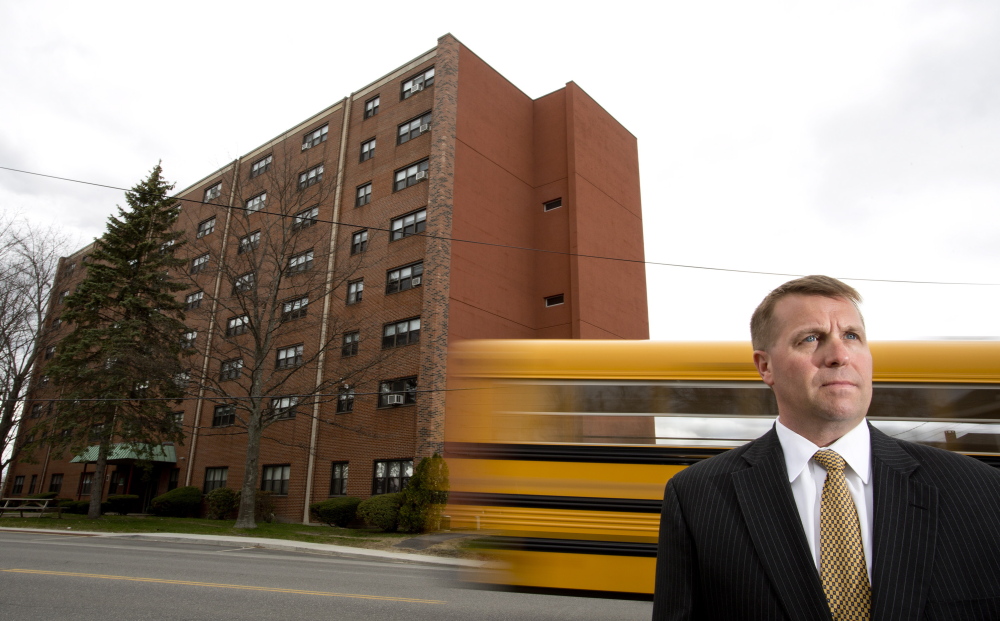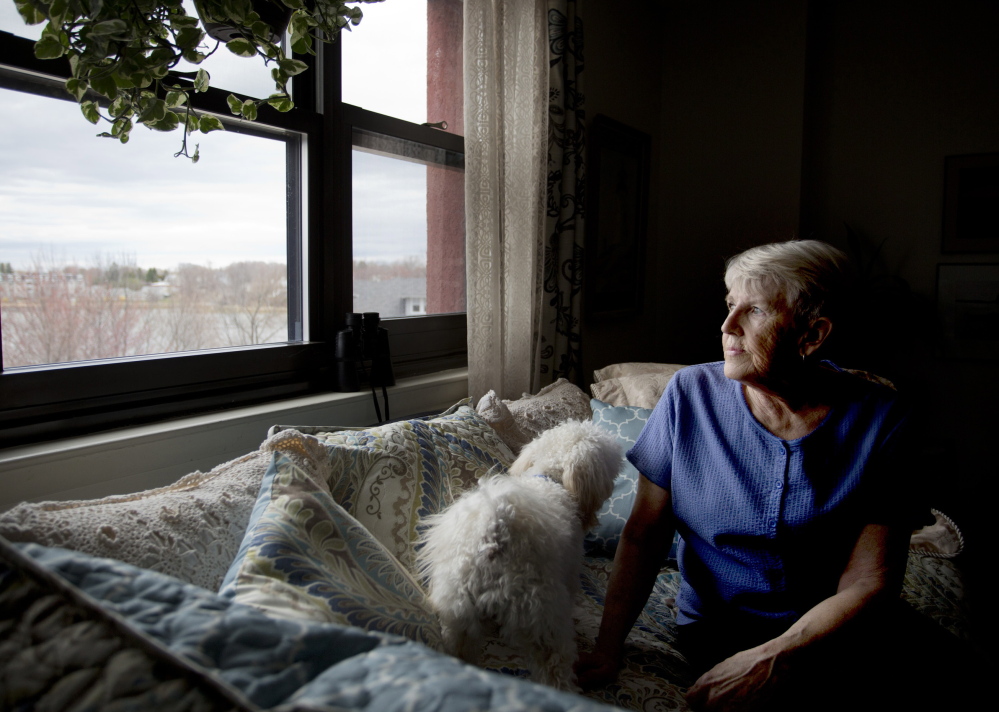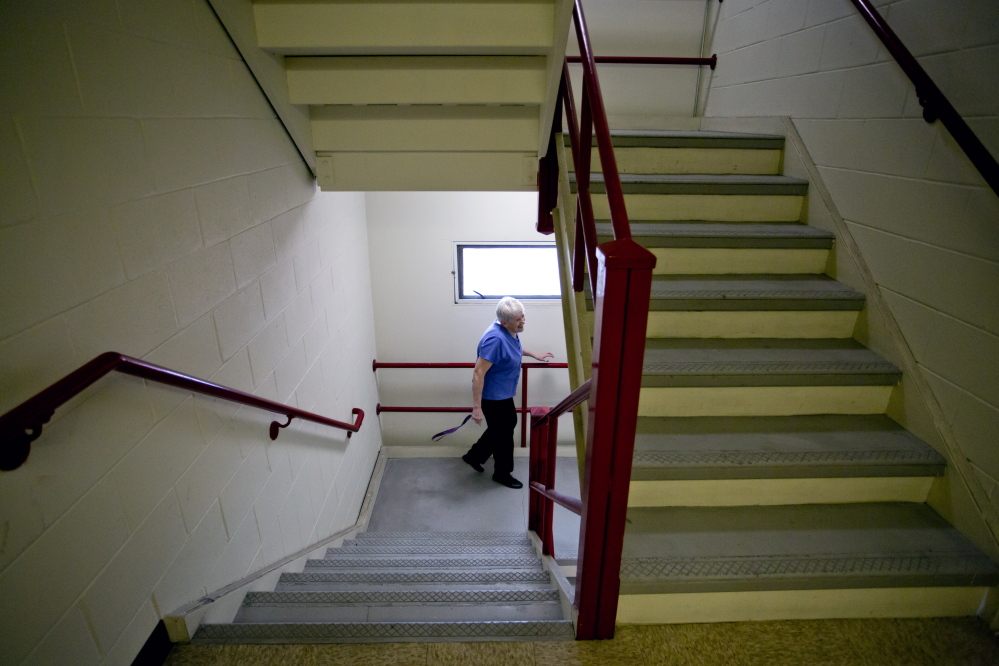SOUTH PORTLAND — Demand for subsidized apartments owned by the South Portland Housing Authority is usually strong, but it’s downright competitive now in buildings shared by low-income senior citizens and disabled younger adults.
Growth in both populations is driving demand for a combined 344 apartments in five properties that were built with funding from the federal Department of Housing and Urban Development, said Michael Hulsey, executive director of the authority.
Constructed in the 1970s and early 1980s, buildings such as 425 Broadway and Mill Cove Apartments that have long housed mostly low-income seniors are increasingly housing low-income adults under age 62 who have physical or mental disabilities, as required under federal anti-discrimination laws.
The percentage of disabled adults leasing apartments in these properties, including St. Cyr Court at 1700 Broadway and Landry Village off Westbrook Street, has grown steadily in recent years, from 19 percent in 2008 to 29 percent in 2010 to 38 percent today, according to the authority. The current waiting list for these properties tallies 144 seniors and 199 disabled younger adults.
“We’re here to provide housing for all populations,” Hulsey said. “But in some of our buildings, we are seeing that the disabled population is growing and the available housing for seniors is shrinking.”
And because younger disabled tenants tend to live longer than their senior neighbors, they’re holding leases longer and reducing turnover, further extending a waiting period that’s already two to three years, Hulsey said.
Tenants who live in these properties, including Broad Pines at 235 Broadway, pay 30 percent of their income in rent, which can be as low as $225 per month for a person who gets $750 in Social Security benefits.
GROWING COMPETITION
Shifting demographics at these low-income properties are proving to be a challenge for the housing authority, the Police Department and some residents, especially when tenants’ lifestyles and behavior conflict.
At 425 Broadway, especially, seniors report being intimidated by some younger residents who act aggressively and openly engage in inappropriate or illegal activity, including the use and sale of illicit drugs. The housing authority has installed security cameras at several properties and hired a security company to conduct regular patrols. The Police Department provides monthly incident reports to the housing authority that show several drug arrests in recent years.
Police Chief Edward Googins said that “425 Broadway is a huge issue for us. The dynamic can get very difficult and we wind up getting called. For the elderly, it can be immensely intimidating and they can feel unsafe.”
Increasing competition for these subsidized apartments also puts South Portland at the epicenter of a widely recognized problem in Maine, where the senior population is growing rapidly and many elders depend on Social Security and live in older housing stock that’s costly and difficult to maintain.
Maine is considered the oldest state, with the highest median age – 43.9 years – and the second-highest proportion of people age 65 and older – 17.7 percent – following Florida’s 18.6 percent, according to the U.S. Census. By 2030, more than 25 percent of Mainers will be 65 or older.
Some state lawmakers are trying to address the growing demand for housing with a bipartisan, $65 million bond bill that would help build 1,000 units of subsidized senior rental housing across Maine. In the past several years, the Maine State Housing Authority has subsidized the development of about 120 senior apartments per year, and only 47 are expected to be built next year.
Housing and senior advocates support the bill, citing a recent Maine Affordable Housing Coalition study that found the state needs 9,000 units of subsidized senior housing now, and as many as 15,000 units by 2022 if little is done to address the growing demand. The Maine Real Estate Managers Association this spring counted 8,975 senior households on waiting lists for subsidized apartments across the state.
Republican Gov. Paul LePage has questioned the validity of the coalition’s study and stated his opposition to the bond bill.
AUTHORITY TAKING SOME STEPS
The South Portland Housing Authority has taken some steps to address the lack of senior housing.
Last year, when the disabled population at the 82-unit Mill Cove Apartments reached 45 percent, the authority got permission from HUD to cap the disabled population in that building at 10 percent, said Lisa Viola, the authority’s deputy director. Now the disabled population at Mill Cove, located at Broadway and Cottage Road and overlooking Portland Harbor and a Hannaford supermarket, is 38 percent, she said.
The authority is developing Ridgeland Gardens, a 44-unit affordable housing complex on Ridgeland Avenue that’s set to open this summer for people age 55 and older. The one-bedroom apartments will rent for $860 per month to individuals with yearly incomes up to $32,400, or $37,020 for two-person households.
It’s an expansion of Ridgeland Estates – an 80-unit complex built in 1993 with low-income housing tax credits – where rents are $500 or $600 per month, according to the authority’s website. However, neither property is considered affordable to many low-income seniors without a hard-to-get Section 8 federal housing voucher, which covers 70 percent of rent.
To streamline the wait for Section 8 vouchers, the authority recently joined with its counterparts in Portland, Westbrook, Auburn and Bath to create a combined waiting list, which currently has 5,991 qualified households, including families, seniors and disabled adults, Hulsey said.
Just over 13 percent of Mainers ages 21 to 64 have a physical or mental disability, compared with 10 percent nationally, according to a 2012 Disability Status Report by Cornell University.
Among Maine’s working-age disabled population, the employment rate fell from 39.5 percent in 2008 to 34.1 percent in 2012, while those who received Social Security disability payments increased from 19.6 percent to 22.4 percent during the same period, according to the Cornell report.
NO STATEWIDE DATA
The Maine State Housing Authority doesn’t have statewide data on the prevalence of disabled adults living in public housing, but agency officials don’t believe the overall percentage is growing, said spokeswoman Deborah Turcotte.
Where increasing need is apparent, housing officials point to an economic recovery that has left some people behind, insufficient programs to address homelessness and addiction, and a significant downsizing of the nation’s psychiatric hospitals in recent decades.
“There never was a comprehensive plan to create community-based housing following deinstitutionalization,” said Mark Adelson, executive director of the Portland Housing Authority.
In Portland’s housing complexes shared by low-income elders and disabled younger adults – Franklin Towers, Harbor Terrace and Washington Gardens – the adult disabled population has reached more than 43 percent across 420 units, Adelson said.
Jane Croston, a resident commissioner of the South Portland Housing Authority, knows firsthand what it’s like to live at 425 Broadway, next to Mill Cove Apartments. Croston, 67, has lived in the eight-story brick building, also overlooking Portland Harbor, for five years.
A retired antiques dealer and nearly lifelong Mainer, Croston wound up needing low-income housing after a severe fall nine years ago led to mounting health problems that put her out of work and drained her finances. Now she lives on $725 a month in Social Security benefits and works as a volunteer helping older seniors.
She balances the beautiful view from her smartly decorated efficiency apartment against seeing drug deals happen on the front lawn and once being threatened in the laundry room by an unstable neighbor.
“There’s no place else for people to go, so some people come here after rehab for drug addiction, from the (homeless) shelter, from the (psychiatric) hospital,” Croston said. “It’s not good when you have 20-year-olds who want to party all night living next to frail elderly who are frightened. The housing authority does a pretty good job trying to keep the place safe, but it’s an ongoing issue.”
Croston agrees with housing officials who say there are troublesome tenants of all ages and backgrounds. But that doesn’t address the immediate challenge facing Croston and many of her friends. She can’t afford to move into pricier housing, and neither can they.
“The need is so huge and the resources are so inadequate,” Croston said. “I know so many seniors who have to sell their houses soon and yet they’re priced out of most apartments.”
Send questions/comments to the editors.





Success. Please wait for the page to reload. If the page does not reload within 5 seconds, please refresh the page.
Enter your email and password to access comments.
Hi, to comment on stories you must . This profile is in addition to your subscription and website login.
Already have a commenting profile? .
Invalid username/password.
Please check your email to confirm and complete your registration.
Only subscribers are eligible to post comments. Please subscribe or login first for digital access. Here’s why.
Use the form below to reset your password. When you've submitted your account email, we will send an email with a reset code.